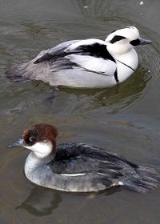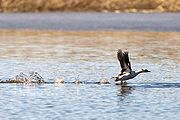
Smew
Encyclopedia
The Smew is a small duck
, which is somewhat intermediate between the typical merganser
s (Mergus) and the goldeneyes
(Bucephala). It is the only member of the genus
Mergellus; sometimes included in Mergus, this genus is distinct (though closely related) and might actually be a bit closer to the goldeneyes. The Smew has interbred with the Common Goldeneye
(B. clangula).
An unnamed fossil
seaduck, known from a humerus
found in the Middle Miocene
Sajóvölgyi Formation (Late Badenian, 13–12 million years ago) of Mátraszõlõs, Hungary
, was assigned to Mergus. However, the authors included the Smew therein, and consequently, the bone is more properly assigned to Mergellus—especially as it was more similar to a Smew's than to the Bucephala remains also found at the site. It is sometimes argued that the Mátraszõlõs fossil is too old to represent any of the modern seaduck genera, but apparently these were all well-distinct even back then.
The living species is known to exist since about 2 to 1.5 million years, as attested by fossils from the earliest Pleistocene
found in England.
; they are often known as "redhead" Smew. It has oval white wing-patches in flight. The Smew's bill has a hooked tip and serrated edges, which help it catch fish when it dives for them.
 This species breeds in the northern taiga
This species breeds in the northern taiga
of Europe
and Asia
. It needs trees for breeding. The Smew lives on fish-rich lakes and slow rivers. As a migrant it leaves its breeding areas and winters on sheltered coasts or inland lakes of the Baltic Sea
, the Black Sea
, northern Germany and the Low Countries
, with small number reaching Great Britain
(for example, at Dungeness), mostly at regular sites. Vagrants have been recorded in North America. On lakes it prefers areas around the edges, often under small trees.
The Smew breeds in May and lays 6–9 cream-colored eggs. It nests in tree holes, such as old woodpecker
nests.
It is a shy bird and flushes easily when disturbed.
The Smew is one of the species to which the Agreement on the Conservation of African-Eurasian Migratory Waterbirds (AEWA
) applies. It is not considered threatened by the IUCN.
Duck
Duck is the common name for a large number of species in the Anatidae family of birds, which also includes swans and geese. The ducks are divided among several subfamilies in the Anatidae family; they do not represent a monophyletic group but a form taxon, since swans and geese are not considered...
, which is somewhat intermediate between the typical merganser
Mergus
Mergus is the genus of the typical mergansers, fish-eating ducks in the seaduck subfamily . The Hooded Merganser, often termed Mergus cucullatus, is not of this genus but closely related...
s (Mergus) and the goldeneyes
Goldeneye (duck)
Goldeneye are small tree-hole nesting northern hemisphere seaducks belonging to the genus Bucephala. Their plumage is black and white, and they eat fish, crustaceans and other marine life....
(Bucephala). It is the only member of the genus
Genus
In biology, a genus is a low-level taxonomic rank used in the biological classification of living and fossil organisms, which is an example of definition by genus and differentia...
Mergellus; sometimes included in Mergus, this genus is distinct (though closely related) and might actually be a bit closer to the goldeneyes. The Smew has interbred with the Common Goldeneye
Common Goldeneye
The Common Goldeneye is a medium-sized sea duck of the genus Bucephala, the goldeneyes. Their closest relative is the similar Barrow's Goldeneye....
(B. clangula).
An unnamed fossil
Fossil
Fossils are the preserved remains or traces of animals , plants, and other organisms from the remote past...
seaduck, known from a humerus
Humerus
The humerus is a long bone in the arm or forelimb that runs from the shoulder to the elbow....
found in the Middle Miocene
Middle Miocene
The Middle Miocene is a sub-epoch of the Miocene Epoch made up of two stages: the Langhian and Serravallian stages. The Middle Miocene is preceded by the Early Miocene....
Sajóvölgyi Formation (Late Badenian, 13–12 million years ago) of Mátraszõlõs, Hungary
Hungary
Hungary , officially the Republic of Hungary , is a landlocked country in Central Europe. It is situated in the Carpathian Basin and is bordered by Slovakia to the north, Ukraine and Romania to the east, Serbia and Croatia to the south, Slovenia to the southwest and Austria to the west. The...
, was assigned to Mergus. However, the authors included the Smew therein, and consequently, the bone is more properly assigned to Mergellus—especially as it was more similar to a Smew's than to the Bucephala remains also found at the site. It is sometimes argued that the Mátraszõlõs fossil is too old to represent any of the modern seaduck genera, but apparently these were all well-distinct even back then.
The living species is known to exist since about 2 to 1.5 million years, as attested by fossils from the earliest Pleistocene
Pleistocene
The Pleistocene is the epoch from 2,588,000 to 11,700 years BP that spans the world's recent period of repeated glaciations. The name pleistocene is derived from the Greek and ....
found in England.
Description
The drake Smew, with its 'cracked ice' appearance, is unmistakable, and looks very black-and-white in flight. The females and immature males are grey birds with chestnut foreheads and crowns, and can be confused at a distance with the Ruddy DuckRuddy Duck
The Ruddy Duck is a small stiff-tailed duck.Their breeding habitat is marshy lakes and ponds throughout much of North America, and in South America in the Andes. They nest in dense marsh vegetation near water. The female builds her nest out of grass, locating it in tall vegetation to hide it from...
; they are often known as "redhead" Smew. It has oval white wing-patches in flight. The Smew's bill has a hooked tip and serrated edges, which help it catch fish when it dives for them.
Distribution and ecology

Taiga
Taiga , also known as the boreal forest, is a biome characterized by coniferous forests.Taiga is the world's largest terrestrial biome. In North America it covers most of inland Canada and Alaska as well as parts of the extreme northern continental United States and is known as the Northwoods...
of Europe
Europe
Europe is, by convention, one of the world's seven continents. Comprising the westernmost peninsula of Eurasia, Europe is generally 'divided' from Asia to its east by the watershed divides of the Ural and Caucasus Mountains, the Ural River, the Caspian and Black Seas, and the waterways connecting...
and Asia
Asia
Asia is the world's largest and most populous continent, located primarily in the eastern and northern hemispheres. It covers 8.7% of the Earth's total surface area and with approximately 3.879 billion people, it hosts 60% of the world's current human population...
. It needs trees for breeding. The Smew lives on fish-rich lakes and slow rivers. As a migrant it leaves its breeding areas and winters on sheltered coasts or inland lakes of the Baltic Sea
Baltic Sea
The Baltic Sea is a brackish mediterranean sea located in Northern Europe, from 53°N to 66°N latitude and from 20°E to 26°E longitude. It is bounded by the Scandinavian Peninsula, the mainland of Europe, and the Danish islands. It drains into the Kattegat by way of the Øresund, the Great Belt and...
, the Black Sea
Black Sea
The Black Sea is bounded by Europe, Anatolia and the Caucasus and is ultimately connected to the Atlantic Ocean via the Mediterranean and the Aegean seas and various straits. The Bosphorus strait connects it to the Sea of Marmara, and the strait of the Dardanelles connects that sea to the Aegean...
, northern Germany and the Low Countries
Low Countries
The Low Countries are the historical lands around the low-lying delta of the Rhine, Scheldt, and Meuse rivers, including the modern countries of Belgium, the Netherlands, Luxembourg and parts of northern France and western Germany....
, with small number reaching Great Britain
Great Britain
Great Britain or Britain is an island situated to the northwest of Continental Europe. It is the ninth largest island in the world, and the largest European island, as well as the largest of the British Isles...
(for example, at Dungeness), mostly at regular sites. Vagrants have been recorded in North America. On lakes it prefers areas around the edges, often under small trees.
The Smew breeds in May and lays 6–9 cream-colored eggs. It nests in tree holes, such as old woodpecker
Woodpecker
Woodpeckers are near passerine birds of the order Piciformes. They are one subfamily in the family Picidae, which also includes the piculets and wrynecks. They are found worldwide and include about 180 species....
nests.
It is a shy bird and flushes easily when disturbed.
The Smew is one of the species to which the Agreement on the Conservation of African-Eurasian Migratory Waterbirds (AEWA
AEWA
The Agreement on the Conservation of African-Eurasian Migratory Waterbirds is the largest of its kind developed so far under the Bonn Convention. It was concluded on 16 June 1995 at The Hague, the Netherlands and entered into force on 1 November 1999 after the required number of at least fourteen...
) applies. It is not considered threatened by the IUCN.
External links
- Smew videos, photos & sounds on the Internet Bird Collection

